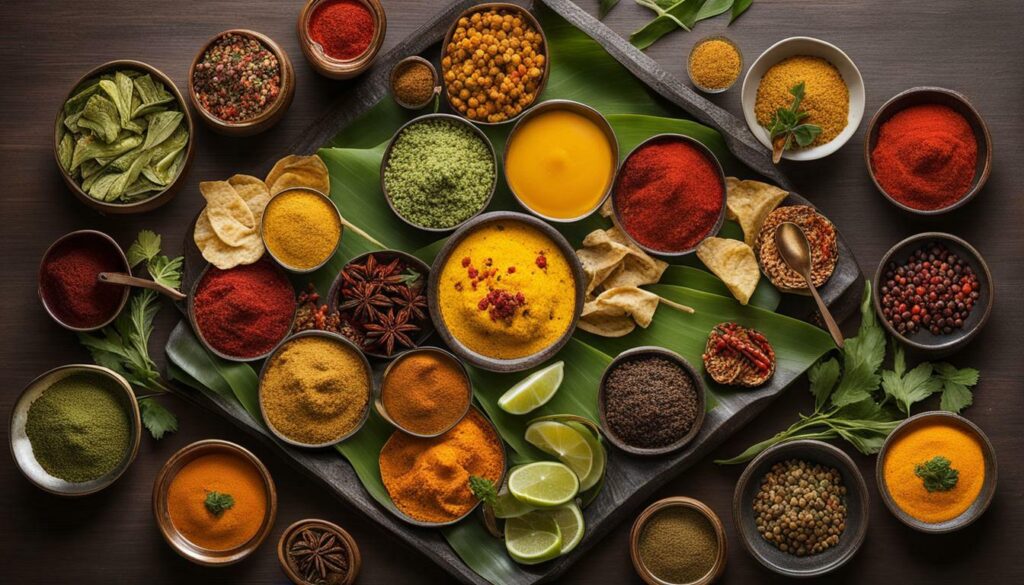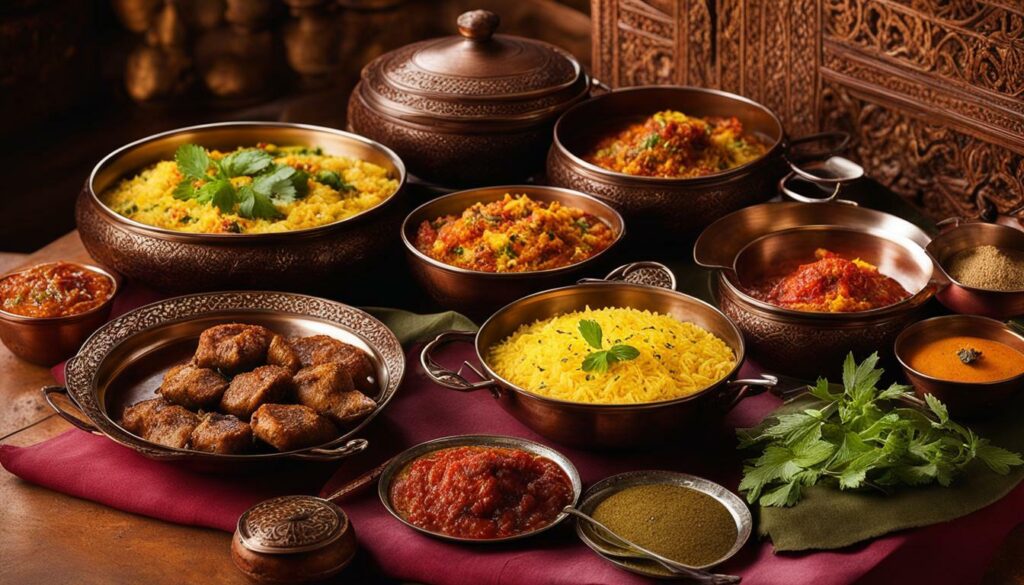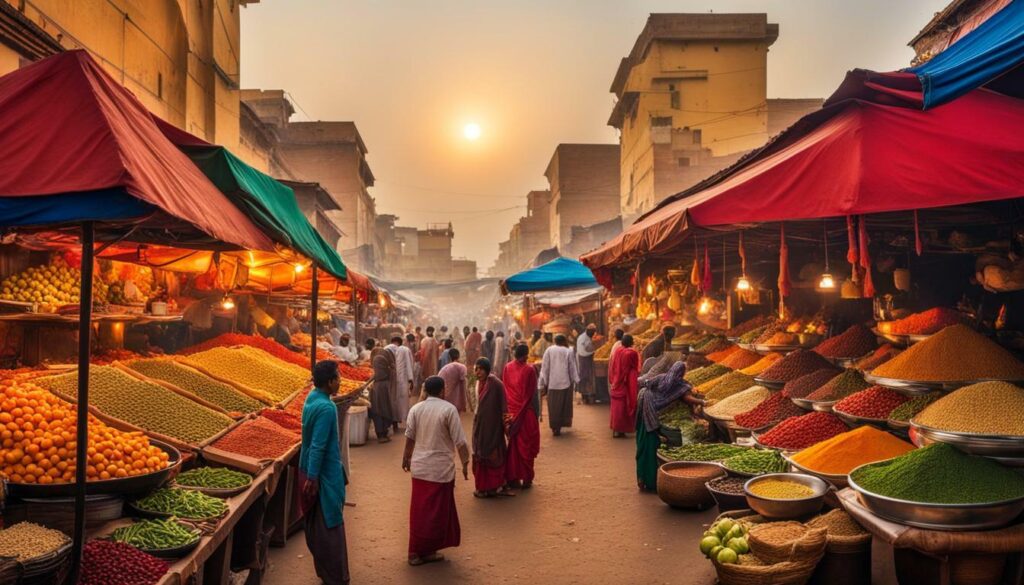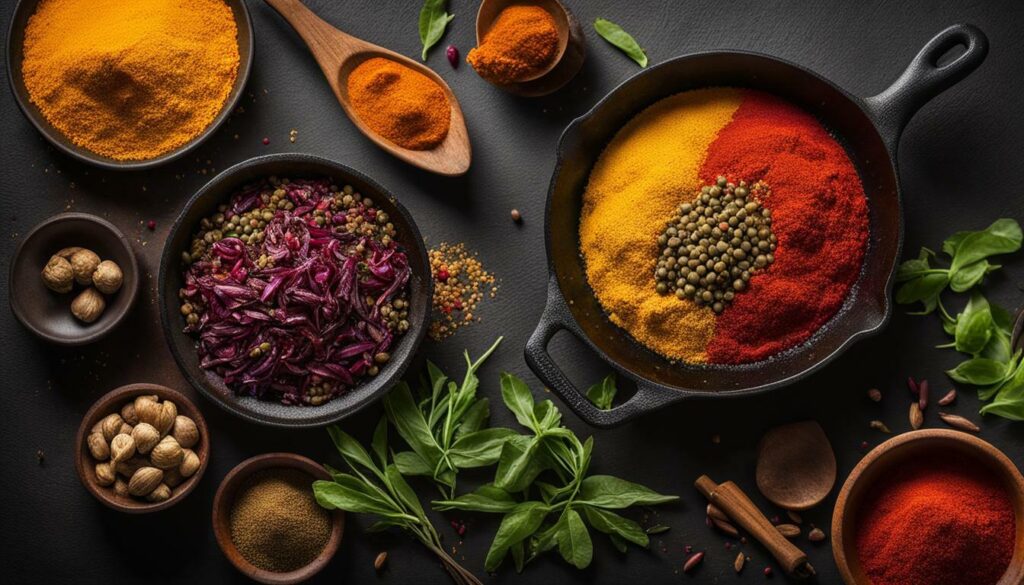The past and present diets of India have been shaped by a diverse culinary history, influenced by factors such as caste, religion, and cultural traditions. This rich heritage has resulted in a wide variety of traditional Indian foods that reflect the country’s vibrant tapestry of flavours and ingredients. From ancient civilizations to colonial influences, the food of India tells a story of evolution, adaptation, and cultural exchange.
As we delve into the past and present diets of India, we gain a deeper understanding of the intricate interplay between food, culture, and identity in this diverse nation.
Key Takeaways
- India’s culinary history is influenced by factors such as caste, religion, and cultural traditions.
- Ancient diets in India included a variety of grains, pulses, vegetables, and meat.
- The Vedic era brought the introduction of crops like rice and millets, along with the continued importance of lentils.
- The Mughals introduced new cooking techniques and ingredients that shaped Indian cuisine.
- The British era saw the fusion of Indian and British cuisines, resulting in unique dishes.
Ancient Diets in India
In ancient times, the diets in India comprised a variety of grains, pulses, and vegetables, with some communities also incorporating meat into their meals. The Indus Valley Civilization, for example, relied on a combination of domesticated and hunted animals for their meat, which was often grilled over an open fire.

Pulses and grains like barley and wheat were also a significant part of the ancient Indian diet. These staple foods provided the necessary nutrients and sustained the population through the centuries. The agricultural practices of ancient India revolved around the cultivation of these crops, ensuring a constant supply of food.
The Indus Valley Diet
The Indus Valley Civilization, one of the world’s oldest urban civilizations, had a diet rich in grains, fruits, and vegetables. Archaeological evidence suggests that the people of this civilization consumed wheat, barley, and rice as staple foods. These crops were grown in abundance, providing sustenance to the community.
Exploring the ancient diets of India gives us insight into the way people lived and ate in the past. It is fascinating to see how various factors like geography, climate, and cultural influences shaped the culinary traditions that are still celebrated today. By examining the past, we can better understand the present and appreciate the rich tapestry of Indian cuisine.
Influence of the Vedic Era
The Vedic era brought significant changes to Indian diets, introducing crops such as rice and millets. Lentils remained a staple source of protein, and food habits were influenced by the caste system, with Brahmins adhering to vegetarianism while lower castes consumed meat.
During this period, rice cultivation became more prominent, especially in the Gangetic plains. The availability of rice led to the development of various rice-based dishes, such as biryani and pulao, which are still popular in India today. Millets, on the other hand, were widely cultivated in drier regions and served as a staple food for many communities.
The Vedic texts, such as the Rigveda and the Atharvaveda, provide valuable insights into the dietary practices of ancient India. These texts mention various rituals and offerings involving food, highlighting the importance of food in religious and cultural contexts. The caste system also played a significant role in determining food preferences, as Brahmins, who were considered the highest caste, followed strict vegetarianism, while lower castes consumed meat.
As the Vedic era progressed, food habits became more diverse, with regional variations based on geographical factors and cultural traditions. Despite these variations, lentils remained a staple source of protein across different regions and castes. Lentils, such as toor dal, moong dal, and masoor dal, continue to be widely consumed in India and are an integral part of many traditional dishes.
| Grains | Pulses | Meat |
|---|---|---|
| Rice | Toor Dal | Goat meat |
| Millets | Moong Dal | Chicken |
| Wheat | Masoor Dal | Fish |
Overall, the Vedic era played a significant role in shaping Indian diets and culinary traditions. The introduction of crops like rice and millets and the continuing importance of lentils showcase the rich diversity of food in India. These dietary practices were intricately intertwined with the caste system and cultural beliefs, further highlighting the complex interplay between food, culture, and identity in India.

Mughal Influence on Indian Cuisine
The Mughals left a lasting impact on Indian cuisine, introducing new cooking techniques, and ingredients like dried fruits and spices, and influencing the evolution of culinary traditions. One of the significant contributions of the Mughals was the introduction of the art of slow cooking, known as ‘dum’ cooking, which involved sealing a pot with dough and allowing the flavours to infuse slowly. This technique resulted in tender and aromatic dishes like biryanis and kebabs, which are still enjoyed today.
The Mughals also brought a wide range of spices from their Central Asian homeland, such as saffron, cardamom, and cloves, which were incorporated into Indian cooking. These spices added depth and complexity to the dishes, creating a unique blend of flavours that became characteristic of Mughlai cuisine. Additionally, dried fruits like raisins and apricots were used to add a touch of sweetness and richness to savoury dishes, creating a delightful contrast of flavours.
The Mughals’ influence on Indian cuisine can be seen in iconic dishes like butter chicken, korma, and biryani, which have become synonymous with Indian culinary traditions. These dishes showcase the rich flavours, intricate preparation techniques, and royal opulence that was characteristic of the Mughal era. Today, Mughlai cuisine continues to be celebrated and enjoyed in India and around the world, showcasing the enduring legacy of this remarkable culinary influence.

Table: Traditional Mughlai Dishes
| Dish | Description |
|---|---|
| Biryani | A fragrant rice and meat dish cooked with aromatic spices and saffron. |
| Sheer Khurma | A rich and creamy vermicelli pudding flavoured with cardamom and garnished with dried fruits. |
| Galouti Kebab | Tender and flavorful minced meat kebabs, traditionally made with finely ground lamb or beef. |
| Nargisi Kofta | Hard-boiled eggs coated with a spiced meat mixture, deep-fried and served with a creamy gravy. |
British Era Fusion Cuisine
The British era witnessed the fusion of Indian and British cuisines, resulting in the creation of dishes like mulligatawny soup, which combined Indian spices with British culinary techniques. This unique blend of flavours showcased the cultural exchange between the British colonizers and the Indian locals, leading to the development of a new gastronomic landscape.
The fusion cuisine of the British era can be seen in other dishes as well, such as kedgeree, a combination of rice, fish, boiled eggs, and spices. This dish was initially introduced by the British as a breakfast option but soon became popular across India. It is worth noting that while these dishes incorporated British ingredients and cooking methods, they still retained a distinct Indian identity.
The introduction of British ingredients and cooking techniques also influenced the traditional Indian thali, a complete meal served on a platter. During the British era, new items like bread and pudding made their way into the thali, alongside staple Indian dishes like dal, rice, and vegetables. This integration of British and Indian elements in the thali reflected the cultural exchange and became a symbol of culinary diversity.
| Traditional Indian Dish | Fusion Dish |
|---|---|
| Biryani | British-inspired Chicken Biryani |
| Dosa | English Breakfast Dosa |
| Pakoras | British-style Onion Bhajis |
While the fusion cuisine of the British era introduced new flavours and cooking techniques to Indian cuisine, it also highlighted the adaptability and creativity of Indian chefs. This period marked a significant chapter in the evolution of Indian gastronomy, as it paved the way for further experimentation and innovation in the culinary landscape.

The Influence of British Era Fusion Cuisine
“The fusion of Indian and British cuisines during the British era not only created unique dishes but also fostered a cultural exchange that continues to shape the Indian culinary scene today.” – Chef Ritu Singh
The fusion cuisine of the British era has left a lasting impact on Indian meals and recipes. It has diversified the choices available to Indian food enthusiasts and showcases the country’s ability to adapt and incorporate different culinary influences. Today, Indian meals are a vibrant mix of traditional dishes, regional specialities, and fusion creations that highlight the rich culinary heritage of the nation.
Indian Street Food A Video Tour
Shift in Modern Diets
In recent times, there has been a noticeable shift in modern diets in India, with higher consumption of low-fibre and refined carbohydrates, potentially contributing to the increased prevalence of insulin resistance syndrome and diabetes. Traditionally, Indian meals consisted of a variety of wholesome and nutrient-rich foods, including whole grains, legumes, vegetables, and healthy fats. However, influenced by urbanization, globalization, and changing lifestyles, dietary patterns have shifted towards convenient and processed foods.
Processed snacks, fast food, and sugary beverages have become more readily available and affordable, leading to their increased consumption. These foods often lack the necessary dietary fibre and are high in added sugars and unhealthy fats, which can negatively impact blood sugar levels and overall health. Additionally, traditional festive foods in India, while rich in flavour and cultural significance, can also be high in calories, saturated fats, and refined carbohydrates.
To combat the potential health risks associated with these dietary shifts, it is essential to promote a balanced and varied diet that incorporates a wide range of whole foods. Including more fruits, vegetables, whole grains, and lean proteins can help increase dietary fibre intake and provide essential nutrients. It is also important to limit the intake of processed and sugary foods, opting for healthier alternatives whenever possible.
| Healthy Food Choices | Unhealthy Food Choices |
|---|---|
|
|

“The shift towards modern diets in India has raised concerns about the potential impact on public health. It is important to educate individuals about the benefits of a balanced diet and encourage the consumption of traditional, unprocessed foods to maintain overall well-being.” – Health Expert
The Importance of Maintaining Traditional Food Practices
While it is natural for diets to evolve over time, it is crucial to preserve the traditional food practices that have been a part of Indian culture for centuries. Traditional Indian foods, such as dal (lentil stew), roti (whole wheat flatbread), and sabzi (vegetable curry), provide a wealth of nutrients and flavours. These dishes not only nourish the body but also connect individuals to their cultural heritage and foster a sense of identity and belonging.
By embracing a mindful approach to food, individuals can enjoy the diversity of Indian cuisine while maintaining a balanced and nutritious diet. Celebrating festive occasions with traditional dishes can be a wonderful way to connect with family and friends, but it is equally important to make conscious choices that prioritize health. By striking a balance between traditional foods and healthier options, individuals can continue to savour the rich flavours of Indian cuisine while promoting optimal health for themselves and future generations.
Historical Document Analysis
Analyzing historical documents and dietary laws provides valuable insights into the evolution of Indian eating habits and their impact on health. These ancient texts reveal the popular and famous foods that were consumed throughout different periods in India’s history. From the variety of grains, pulses, and vegetables consumed in ancient times to the fusion of Indian and British cuisines during the British era, food has played a significant role in shaping Indian culture.
One interesting aspect of Indian cuisine is the use of spices, which add flavour and depth to dishes. Spices like turmeric, cumin, and coriander have been widely used for centuries and are known for their medicinal properties. Traditional Indian meals often feature a balance of rice or bread, lentils, vegetables, and yoghurt, providing a combination of proteins, carbohydrates, and probiotics to support overall health.

The diverse regional cuisines of India also contribute to the popularity of the country’s food. Each region is known for its unique dishes and culinary traditions. For example, in the north, you’ll find rich and creamy curries like butter chicken and naan bread, while the south is famous for its spicy and flavorful dishes like dosas and sambar. The west and east have their own distinct cuisines, such as the seafood delicacies of Goa and the sweets of Bengal.
| Region | Famous Dish |
|---|---|
| North | Butter Chicken |
| South | Dosa |
| West | Goan Fish Curry |
| East | Rasgulla |
Exploring the famous foods of India not only provides a culinary adventure but also gives a glimpse into the rich history and culture of the country. From the ancient diets influenced by caste and religion to the fusion of flavours brought by different rulers, Indian cuisine continues to captivate taste buds around the world. By understanding the past and present diets of India, we can appreciate the importance of food in the cultural and social fabric of this vibrant nation.
The Interplay Between Food, Culture, and Identity
Food in India plays a significant role in shaping cultural and individual identities, showcasing the diversity and richness of the country’s culinary traditions. From the ancient diets influenced by caste and religious practices to the fusion of cuisines during the British era, Indian food reflects the complex interplay between tradition, innovation, and cultural exchange.
Indian cuisine is a tapestry of flavours, spices, and techniques that vary from region to region. Each state has its own signature dishes and cooking styles, influenced by local ingredients and cultural practices. For example, the coastal regions of India rely heavily on seafood, while the northern states are known for their robust vegetarian curries. This range of culinary diversity reflects the vast cultural landscape of India, where food serves as a means of expression and celebration.
The interplay between food, culture, and identity is further enhanced by the rituals and traditions associated with Indian cuisine. Festivals and special occasions are marked by elaborate feasts prepared with love and devotion. These meals not only nourish the body but also reinforce community bonds and preserve cultural heritage. From the colourful and aromatic biryanis of Hyderabad to the delectable sweets of Bengal, every dish tells a story and holds deep cultural significance.
As Indian cuisine continues to evolve and adapt to modern influences, it remains rooted in tradition and acts as a powerful symbol of identity. Whether it is the use of specific spices, the technique of slow cooking, or the art of serving food on banana leaves, these culinary practices connect individuals to their roots and remind them of their heritage. Food in India is more than just sustenance; it is a reflection of history, culture, and the ever-evolving identity of a diverse nation.

| Region | Signature Dish |
|---|---|
| Punjab | Butter Chicken |
| Kerala | Appam with Stew |
| Gujarat | Dhokla |
| Rajasthan | Daal Baati Churma |
“Food is our common ground, a universal experience.” – James Beard
Conclusion
The exploration of the past and present diets of India reveals a fascinating journey through culinary history, highlighting the influence of factors such as caste, religion, and cultural traditions on food choices and habits. In ancient times, a variety of grains, pulses, and vegetables formed the foundation of the Indian diet, with the inclusion of meat in some communities. The Indus Valley Civilization relied on a combination of domesticated and hunted animals for their meat, while pulses and grains like barley and wheat were staple foods.
During the Vedic era, the introduction of crops such as rice and millets and the continued importance of lentils as a protein source shaped Indian diets. The caste system played a significant role, with vegetarianism being followed by Brahmins and meat consumption by lower castes. The influence of the Mughals brought about culinary changes, including the introduction of new cooking techniques and ingredients like dried fruits and spices. The British era witnessed the fusion of Indian and British cuisines, resulting in unique dishes like mulligatawny soup.
In recent times, there has been a shift towards a more frequent consumption of low-fibre and refined carbohydrates, which may contribute to the increased prevalence of insulin resistance syndrome and diabetes in India. Analyzing ancient dietary laws and historical documents provides insights into the evolution of Indian eating habits and their impact on health. Overall, the exploration of India’s past and present diets emphasizes the intricate interplay between food, culture, and identity in this diverse country.
What were the main factors that shaped the diets of ancient Indians?
The diets of ancient Indians were shaped by factors such as caste, religion, and cultural traditions.
What were some common foods consumed by ancient Indians?
Ancient Indians consumed a variety of grains, pulses, and vegetables. The meat was also a part of the diet for some communities, with the Indus Valley Civilization relying on a combination of domesticated and hunted animals for their meat.
What new crops were introduced during the Vedic era?
The Vedic era introduced new crops such as rice and millets, which became important staples in the Indian diet.
Did the caste system influence food habits in ancient India?
Yes, the caste system played a role in determining food habits. Brahmins adhered to vegetarianism, while lower castes consumed meat.
How did the Mughals influence Indian cuisine?
The Mughals brought about changes in Indian cuisine, introducing new cooking techniques and ingredients like dried fruits and spices.
What fusion of cuisines occurred during the British era?
During the British era, Indian and British cuisines fused, resulting in dishes like mulligatawny soup.
How has the modern diet shifted in India?
There has been a shift towards more frequent consumption of low-fibre and refined carbohydrates, which may contribute to the increased prevalence of insulin resistance syndrome and diabetes.
How can the study of historical documents help understand Indian eating habits?
The study of historical documents allows us to understand the evolution of Indian eating habits and their impact on health.
What role does food play in Indian culture and identity?
Food choices and culinary traditions in India reflect the diverse cultural landscape of the country, contributing to the interplay between food, culture, and identity.
Source Links
- https://pubmed.ncbi.nlm.nih.gov/26206172/
- https://www.asianstudies.org/publications/eaa/archives/exploring-indian-culture-through-food/
- https://journalofethnicfoods.biomedcentral.com/articles/10.1186/s42779-022-00129-4



